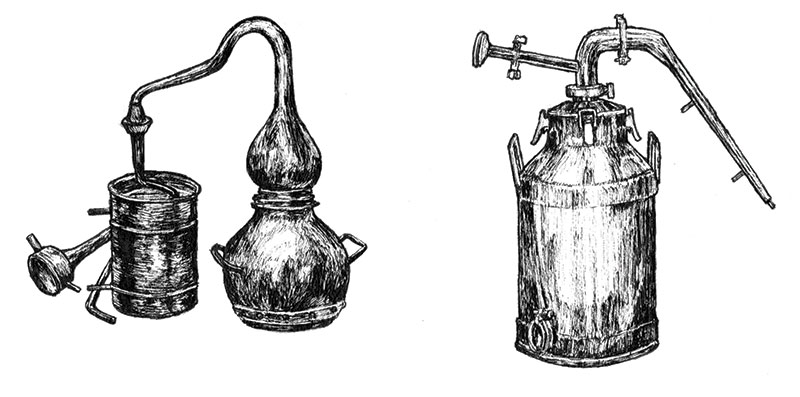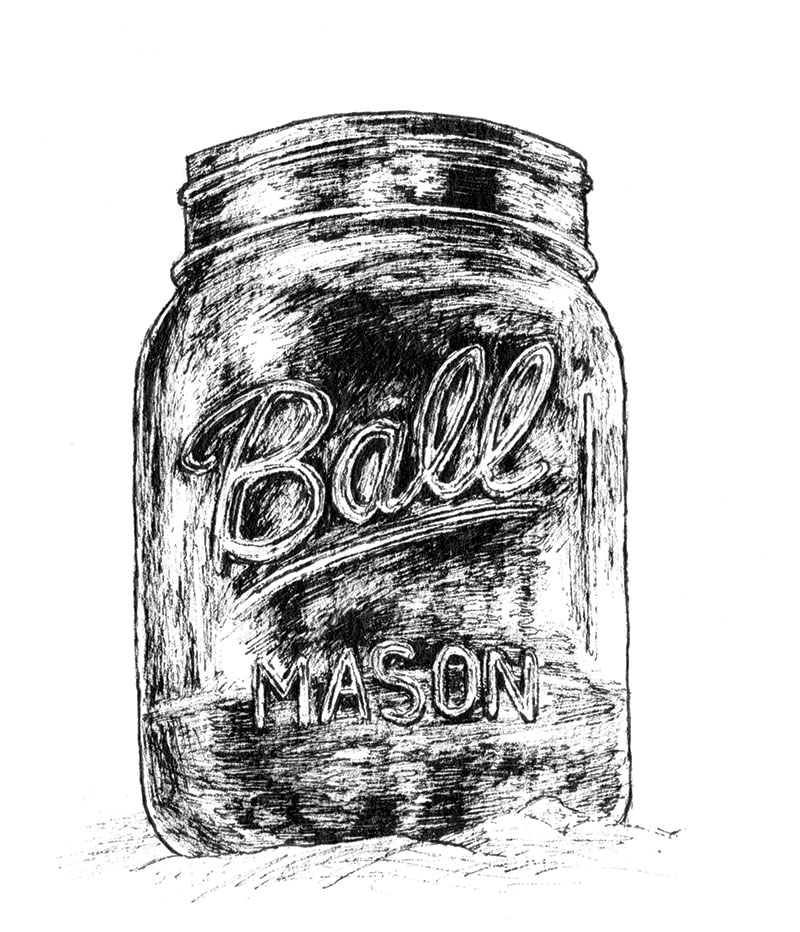Section 5601 of the U.S. revised code provides a penalty of up to five years in prison and/or a $10,000 fine for unlicensed or improperly licensed production of distilled spirits for human consumption. The Alcohol and Tobacco Tax and Trade Bureau makes clear that the licensing and taxation of distilled spirits makes it impractical for the non-commercial hobbyist. Nonetheless, people do it every day. Even if you live in the upscale part of Laurelhurst, and all your neighbors work in medicine, law, or sales, that clean-cut dad who goes out for a 5 a.m. run before heading to the office in a Lexus might be running an illegal still right under your nose. He might sit out in his garage at night, puffing a cigar (or a joint!), watching the ethanol boil out of five gallons of wash. Every now and again he might smell and taste the clear fluid running from the end of a condenser, ensuring that he cuts only the purest heart from the body of volatile alcohols escaping the pollution of water.
Hard liquor being legal and relatively affordable, people’s motivations for transgressing state and federal laws to produce booze that likely won’t rival the stuff turned out by the Noe family—or even the Shapira family—are perplexing. The great spirits of the world are produced by apparently alchemistic processes, and mature on a timescale that, measured in sober years, is nearly-geological. On the other hand, moonshine’s reputation is best declaimed by its aliases: White dog, White lightning and Popskull! You could go blind! It could explode! I assumed that thirst for excitement, rather than drink, spurred the urban bootleggers of Portland. Not so.
A play date is an inauspicious beginning to a story about illegal home distilling. But my first interview had me knocking on the heavy wooden door of a nicely renovated two-story craftsman in the Alberta Arts district at 10 a.m., little girl holding my hand.
“Will they have toys?”
“I’m sure they will.”
“Will they let me play with them?”
“I don’t see why not.”
One of the first things Crackerjack tells me when we get down to business is that he’s allergic to alcohol. Mother of what-the-fuck am I doing here?
“What happens?”
“I get really bad migraines from just one beer. I mean, I drink, but when I do, I drink a lot.”
“Since you’re paying for it either way.”
Crackerjack started distilling in 2001 since, “everybody was brewing already, and they were so far ahead of me, I figured I’d try something different.” He thought for a while that maybe the impurities in the drink were what caused his allergic reaction. He set about trying to distill something so pure that he could drink it without ill effect. This is not the case. Poor Crackerjack! He gives me a little technical lowdown, but I assure him nobody gives a shit about that. Between snacky time, and ensuring that the dangerous silence of unseen children won’t end in screams, crashes, or poop on the rug, I learn that Crackerjack hasn’t distilled for a while, but he still has some of the stuff.
Since purity didn’t alleviate his suffering, Crackerjack moved from reflux distillation (which easily produces a highly refined product) to pot distillation (which leaves in more of the delicious nasties). A pot still is a tall cooking vessel with a cap from which extends a hose or tube. The tube points downward and features some type of condenser along its length. The condensed liquid has a higher ethanol concentration than the the liquid in the cooking vessel, known as the wash. It also has a higher concentration of various impurities. Some of those impurities (fusel alcohols, among others) add some of the flavor profile to the traditionally yellow liquors: whiskey, rum, tequila, and so forth. They also exacerbate hangovers. A home distiller typically doesn’t produce enough to fill a 55-gallon whiskey barrel, and most can’t wait years for aging. Instead, they add wood chips to the base spirit. Crackerjack’s distillate is made from a sour mash wash, meaning that he reserves some of the spent grain and yeast from each batch to start the next one fermenting.
“Should we go taste some of this hooch?” I finally ask in my most polite begging tone, feeling the opportunity slip away with every potty break.
“Yeah, put your shoes on, I’m remodeling the basement.”
He’s heading for the door, I’m heading for my shoes when his wife bursts in. One of the children went outside to bother Mommy—and pissed his pants. It’s lunchtime. Pants need changed. What’s this mess on the floor? Dads need to step it up so she can do her thing…I can’t believe this is happening. Dads need to taste whiskey.
But somehow, miraculously, it works. Pants get changed. Snacks get doled. Children find relatively benign things to occupy themselves with. Crackerjack brings up three half-gallon jars of yellow liquid and sets them on the counter. One’s marked “French 49%,” one’s marked “Toast 49%,” and one’s just marked “Toast.”
“So, the ‘French’ is French oak and the other two are toasted American Oak?”
Nods.
I learn that the one marked simply “Toast” is 80 percent alcohol. We start with the “Toast 49%.”
The aroma is vanilla, more vanilla than vanilla. The synthesis of vanillin is one of the riot of chemical reactions that occurs between the aging booze and the wood. The tannin is powerful, maybe a little too astringent. But between the potency and the tannin, there’s little of that overbearing caramel sweetness that plagues my least favorite bourbons.
The “French 49%” was more refined. The aroma was cognac, then it was smooth with just a little tannin and a subtleness I’d never found in a whiskey. It wasn’t bland exactly, like Canadian blended whisky, just center of the profile. The cask-strength “Toast” is too tough to handle. Nevertheless, my apprehensions of methanol-induced splitting headaches fade with each sip.
Some days later, I’m standing in a garage in North Portland with a shot of white dog in one hand and an American Spirit in the other. I’m supposed to have long quit this smoking bullshit, but I imagine the nihilism of plain ethanol consumption is working on me. In the corner of the garage stands a reflux still made from a pressure cooker from which protrudes a tall column of three-inch copper pipe. The column, I’m told, is packed with marbles. The packing serves as an obstacle course for the steam rising from the wash in the cooker. Only the most energetic (i.e., volatile) of the gasses make it to the copper condenser coils above the column, the rest condense on the marbles, and drip back down to the cooker below. Ethanol is more volatile than water, so there you have it.
A life-size, black-and-white photo of a handsome young sailor and a pretty girl hangs behind the still. The guy who built the still—son of the sailor in the photo apparently—was by look, demeanor, and admission a former Burner, high in the Burner pantheon. He says he doesn’t want to be named in this piece. I say that’s fine, everybody gets a pseudonym.
“Can I pick my own pseudonym?”
I pause for a second, “Mmm…sure.”
“Tuesday Special.”
Whatever you want.
Tuesday Special lives in a teal cottage on an unimproved and hard-to-find road in the heart of North Portland. It’s like the Portland holler. He tells me he got into distilling a couple of years ago to hedge against hard times. He’s done the math—and homemade hooch is cheap. Apparently, his grandfather used to distill to supplement his farm income during the depression. He said that Grandpa Special used to grind horseradish, and he delivered the jarred horseradish to restaurants as a front for liquor deliveries.
“You get an idea of how tough he was—he ground the horseradish without a mask.”
I’ve ground fresh horseradish myself, and I know its violence. Although the story sounds vaguely absurd, I believe it because of that detail. I recall the story Tuesday Special told me when I first met him. He said that when they built the first floating home on Lake Billy Chinook, the crayfish smelled the food in the house and all started migrating into it. I was hooked. Then he said that the crayfish swarmed the house so thickly, all hanging from one another from the sides and the bottom of the house, like a nightmarish Barrel of Tiny Lobsters toy, that it sank to the bottom of the lake. And I called him out on that. But I didn’t call him out this time. Maybe it is the truth. Really, how much of this story is true?
Tuesday Special makes his white dog from corn sugar and turbo yeast. After distillation, he filters it through a Brita. White dog isn’t really the right name for these charcoal-filtered reflux distillations. They’re like cocoa butter, like a Key West Beach, like a Jimmy Buffet song. You could put it in a glass with some ice and an umbrella, stick a lime wheel on the side, and think it was a very subtle cocktail. It’s not exactly to my taste—I like to taste my own death in my booze—but Tuesday Special says his dad once tried it and said, “that would make your grandpa proud.”
Slim’s wormwood-infused filtered spirit is more my style. Slim is a catering manager. He deals with customers, professionals, and service industry riff-raff alike, well into overtime. Slim is as refined as his distillate. Slim is generous. Slim goes to lengths for purity. After fermentation, he pours a charcoal suspension into the mash to draw down the suspended yeast and unfermented sugar. After he filters the wash with a Brita, he distills thrice in a machine that looks like a vacuum coffee pot, filtering the distillate through a Brita each time. They call that “charcoal polishing.” What Slim produces tastes gentle as water. He claims it would be cleaner if he used the man-sized reflux still in his basement, but I’m not sure.
A distiller will discard the beginning of the run (the head) which is rich with toxic methanol, and the end of the run (the tail) which is high in fusel alcohols. Only the best “cut” (the heart) is retained, which is composed primarily of ethanol, the stuff that gets you drunk. Depending on the style of booze, the distiller cuts more or less close to the heart. However, alcohol and water form an azeotropic mixture. This means that, in the right ratio, the mixture is more volatile than either of the components. Effectively, distillation will never yield and absolutely pure product. The purest liquid obtainable by distillation is 96.5 percent ethanol. Slim cuts pretty close to the heart.
Slim pours me tastes of his liquors: cask strength, vanilla, ginger, sassafras, cucumber, wormwood, and marijuana. Vanilla, surprisingly, is harsh from the tannin of the pods. The wormwood is strong too. Bitter as medicine, it satisfies my need for gustatory punishment, in exactly the right way. Marijuana is the surprising winner. Jade green, grassy, and herbaceous, it doesn’t stink like a dreadlocked Eugene protest smoke-out; it smells like subtle herb. I guess that—even though he offered me more of whatever I’d like—he doesn’t want me to go nuts on it. So I satisfy myself with a big taste.
Standing around in Tech’s garage, looped from an afternoon of tasting high octane liquor on empty stomachs, Big Game, Tech and I all agree: there is something indefinably pleasant about a booze that, as Big Game put it, “Kicks you in the teeth.” Bourbon is mostly too sweet. Scotch, Tech and I agree, is just too bizarre. Peat smoke tastes like burning compost, definitely for strivers and actual Scotsmen.
My buddy Big Game introduced me to Tech. Tech lives in a new, big house in a nice neighborhood, has the right haircut, a lean figure, and an inborn affability, but his booze is like sandpaper. His go-to spirit, hit upon after a couple years of experimentation, is 95 proof and serves mainly as a vehicle for the abrasive tannin of Oregon white oak. It dries the mouth like an unripe persimmon, and the aroma of a wood shop lingers for longer than is absolutely comfortable. I like that.
Despite the strictly bourgeois trappings of Tech’s home and garage (nice bikes, granite countertops), his still looks the most like something a real hillbilly would pull together from the general store. A speckle-ware stockpot is topped by a long column of two-inch copper pipe (packed with steel scrubber, I’m told) that joins at a crazy angle with a length of one-inch copper pipe. The hand-wound copper condenser coil sits in another pot that he presumably has to refill with ice periodically. The joints all display the glopped-on soldering of an amateur, and the gasket between the lid and the base of the pot is made of some paint-on rubber material. But it works.
Tech’s cask strength is 175 proof. At this level of purity there are still plenty of aromatic and flavoring compounds in the finished whiskey. He started out using a pot still, but switched to reflux distillation for its greater ease. Pot distillations require at least two runs to get clean enough to comfortably drink; a reflux column gets you an acceptable beverage after just one. He also initially used Turbo yeast, since that’s what most reflux distillers use. Since he wasn’t really going for a super clean base, but a slightly dirtier whiskey profile, he switched to a whiskey yeast. We tasted our way through his earlier experiments, then moved on to his more recent stuff. The difference was impressive.
“That’s the way I like it right there, heavy on the wood, heavy on the whiskey,” Tech says in a boozer’s gravelly draw, the whiskey having sanded off some of his polish.
If a drink signifies the imbiber, then distillers really create themselves, rather than allow themselves to be created. Martinis for white-shirted professionals, American lager for the proles. Beer geeks prattle on about IBU’s and esters. Serious drinkers huddle over their unbidden gin and tonics, wetting the wings of the moths in their minds. Sybarites strive to stand out by ordering the most recently imported Italian Amaro, or scarcest bourbon. From the raw materials of water, sugar and heat, moonshiners draw out the drink, cut off the head and the tail, and poison themselves with whatever heart they please.





The Head, the Heart, and the Tails | Mike Allen
[…] A series of profiles of Portland moonshiners, for PDX Magazine. […]